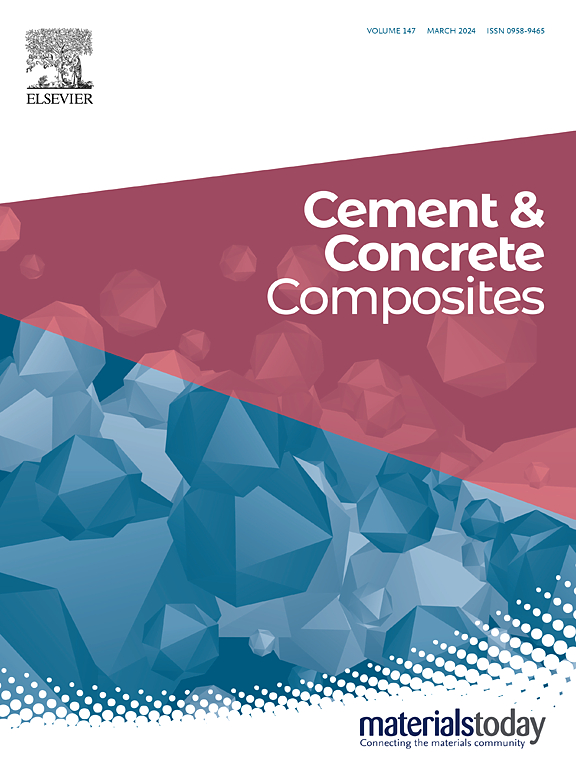低速冲击下3D打印工程胶凝复合材料(3D - ecc)梁的各向异性弯曲行为和能量吸收
IF 13.1
1区 工程技术
Q1 CONSTRUCTION & BUILDING TECHNOLOGY
引用次数: 0
摘要
本研究系统研究了各向异性3d打印工程胶结复合材料(3d - ecc)梁在低速冲击下的力学行为和能量吸收特性,重点研究了不同加载方向下的性能变化。采用拟静态压缩、拉伸、三点弯曲、低速冲击等综合试验方案,对3d -p - ecc在U、V、W加载方向上的力学响应及破坏机制进行了评价。结果表明,与Cast-ECC相比,3d - ecc具有明显的各向异性。具体来说,w方向的抗弯强度增加了33.4%,同时增强了能量吸收能力,提高了韧性,降低了应变率敏感性。此外,研究人员还开发了一种计算惯性力的新方法和能量吸收的预测模型,将冲击能量分为与基体断裂、纤维-基体相互作用和惯性效应相关的组件。研究结果表明,3d - ecc在w方向上具有最佳的抗冲击性,而在u方向上具有最大的惯性力和加速度,这可能对结构完整性构成风险。该研究为3d - ecc在抗冲击基础设施中的优化和应用提供了有价值的见解。本文章由计算机程序翻译,如有差异,请以英文原文为准。
Anisotropic flexural behavior and energy absorption of 3D printed engineered cementitious composites (3DP-ECC) beams under low-velocity impact
This study systematically investigates the mechanical behavior and energy absorption properties of anisotropic 3D-printed engineered cementitious composite (3DP-ECC) beams under low-velocity impact, with a focus on performance variations across different loading directions. A comprehensive experimental program, including quasi-static compression, tensile, three-point flexural, and low-velocity impact tests, was conducted to evaluate the mechanical response and failure mechanisms of 3DP-ECC in the U, V, and W loading directions. The results demonstrate that 3DP-ECC exhibits significant anisotropy compared to Cast-ECC. Specifically, the W-direction exhibited a 33.4 % increase in flexural strength, along with enhanced energy absorption capacity, improved toughness, and reduced strain-rate sensitivity. Additionally, a novel methodology for calculating inertial forces and a predictive model for energy absorption were developed, categorizing impact energy into components associated with matrix fracture, fiber-matrix interactions, and inertial effects. The findings indicate that 3DP-ECC in the W-direction offers optimal impact resistance, while the U-direction exhibits the highest inertial force and acceleration, which may pose risks to structural integrity. This research offers valuable insights into the optimization and application of 3DP-ECC in impact-resistant infrastructure.
求助全文
通过发布文献求助,成功后即可免费获取论文全文。
去求助
来源期刊

Cement & concrete composites
工程技术-材料科学:复合
CiteScore
18.70
自引率
11.40%
发文量
459
审稿时长
65 days
期刊介绍:
Cement & concrete composites focuses on advancements in cement-concrete composite technology and the production, use, and performance of cement-based construction materials. It covers a wide range of materials, including fiber-reinforced composites, polymer composites, ferrocement, and those incorporating special aggregates or waste materials. Major themes include microstructure, material properties, testing, durability, mechanics, modeling, design, fabrication, and practical applications. The journal welcomes papers on structural behavior, field studies, repair and maintenance, serviceability, and sustainability. It aims to enhance understanding, provide a platform for unconventional materials, promote low-cost energy-saving materials, and bridge the gap between materials science, engineering, and construction. Special issues on emerging topics are also published to encourage collaboration between materials scientists, engineers, designers, and fabricators.
 求助内容:
求助内容: 应助结果提醒方式:
应助结果提醒方式:


